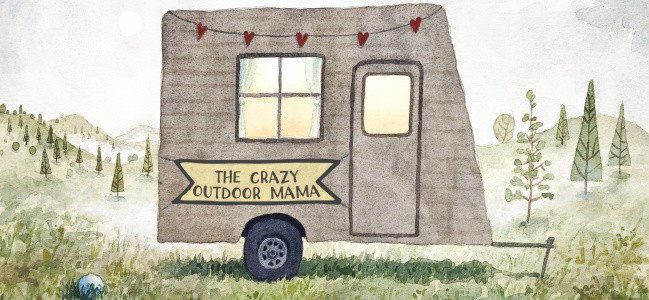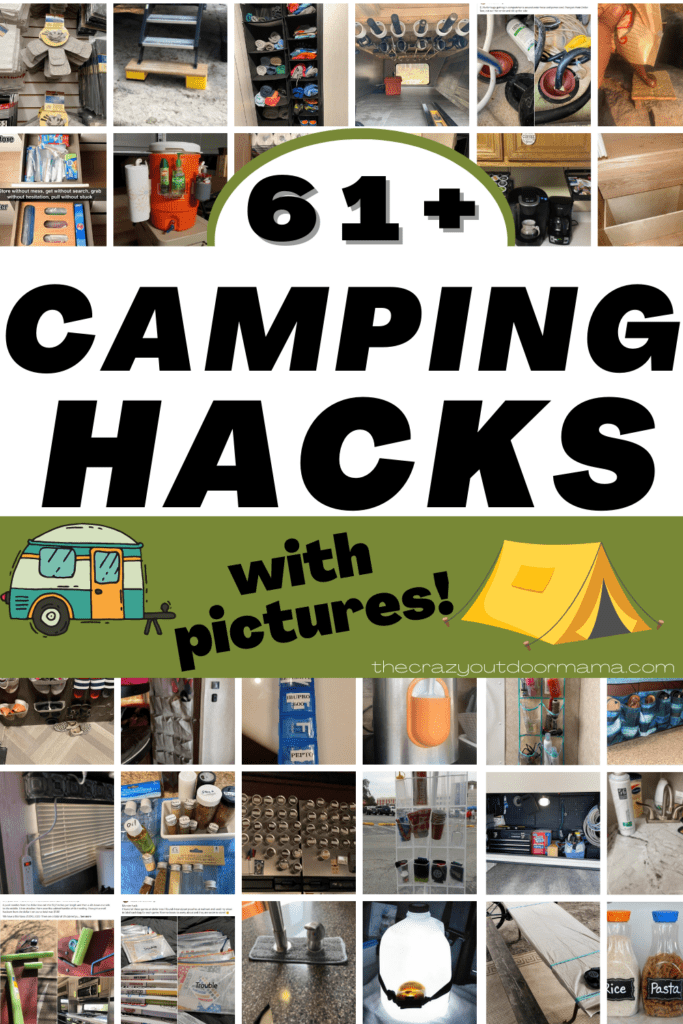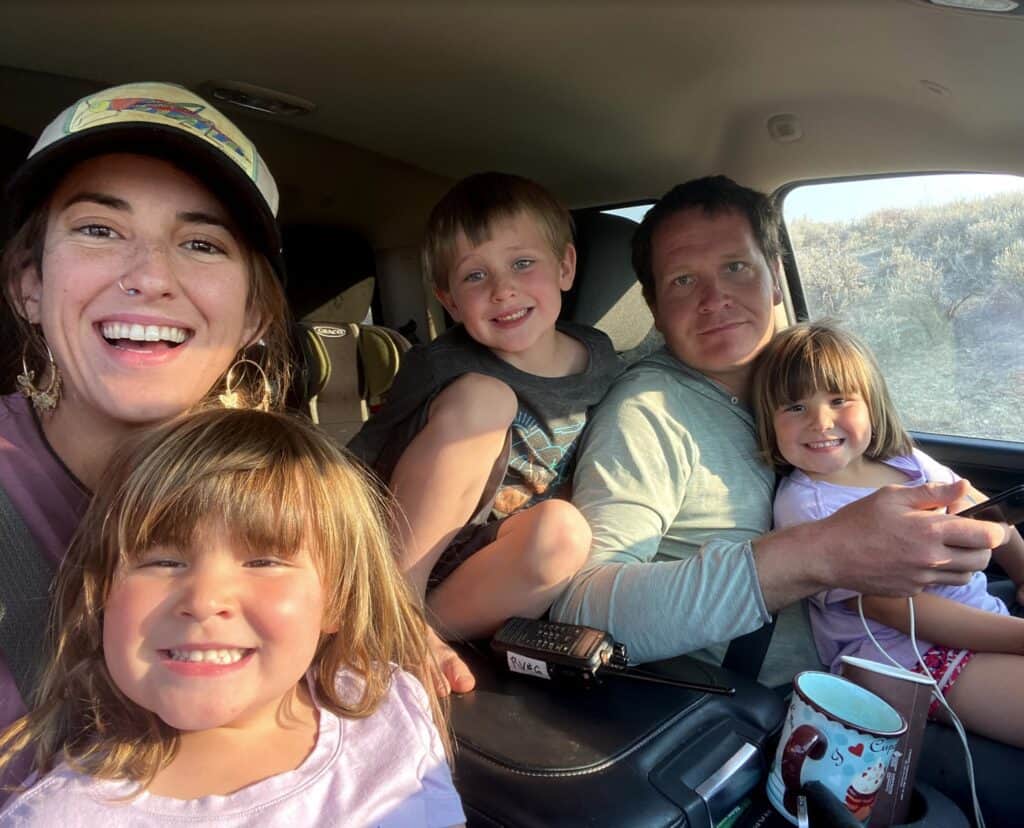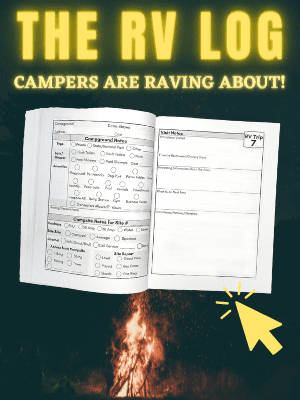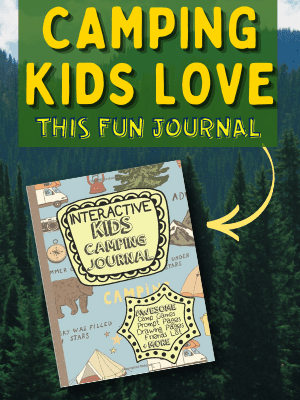More people are spending time outdoors backpacking, hiking, and camping, which is why it’s more important than ever we all learn how to “Leave No Trace”… and what better way to learn than with this free printable Leave No Trace worksheet for kids??
Our outdoor activities can really take a toll on mother nature – litter, polluted water sources, effects on wildlife, and even wildfires. Don’t you just hate seeing campsites and trails littered with garbage!?
To help combat our negative effects on mother nature, the Leave No Trace Center for Outdoor Ethics helps take the lead in educational programs and projects to help us humans have a minimal impact on the beautiful outdoors. Their Leave No Trace Seven Principles are the foundation of their programs.
So what are the 7 Leave No Trace Principles and how can you use them on your next backpacking trip?
Let’s have a quick look at the principles and simple steps you can take to apply each one. ***And don’t forget to get your FREE PDF Leave No Trace Printable! There’s a cute printable version for kids!***
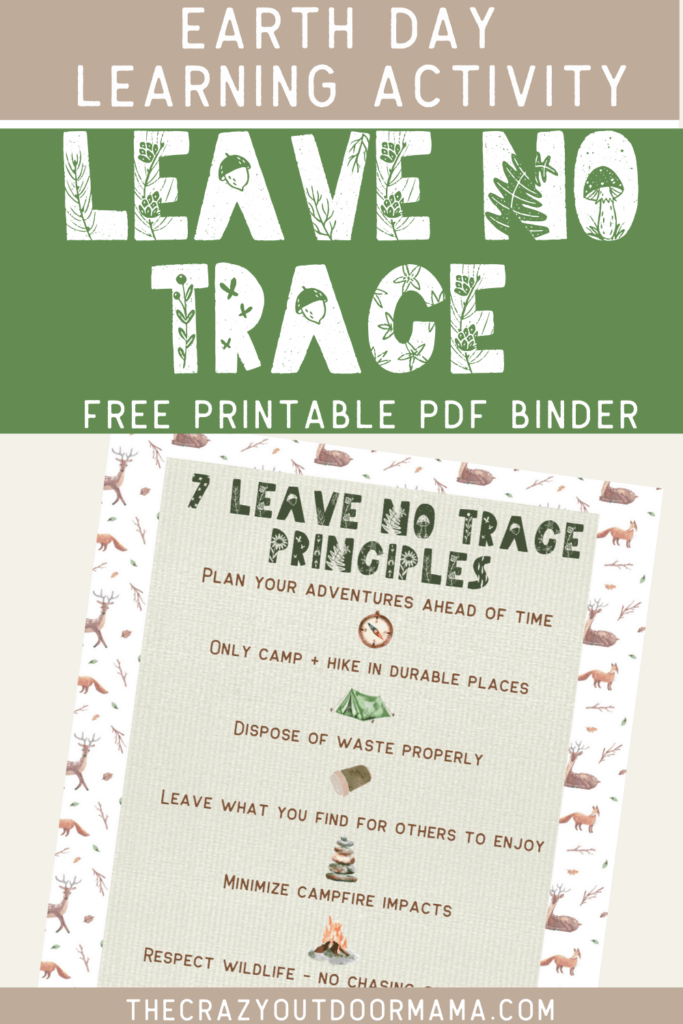
Table of Contents
What Is Leave No Trace?
Leave No Trace refers to the best practices we all should follow in order to protect and preserve the outdoors. Leave No Trace is sometimes referred to with the acronym “LNT”.
Is Leave No Trace Just A List Of Rules?
No. Instead of focusing on a long list of dos and don’ts, Leave No Trace focuses on helping people to make responsible decisions based on a framework of basic principles. They are guidelines you can apply whether you’re backpacking on a trail in the Smoky Mountains or hiking the rainforests of the Pacific Northwest.
You could even say that the Leave No Trace principles help us have fewer rules. If we all work together to follow Leave No Trace best practices, then there won’t be a need for huge park bulletin boards with pages of fine print rules of what you can and can’t do in the park.
Why Use Leave No Trace Principles When Backpacking, Hiking, and Camping?
Although the Leave No Trace principles started mostly as a way for backcountry backpackers to preserve untouched wilderness areas, really everyone who spends time outdoors should follow them. Even picking up your dog’s doo-doo from the local park is a way to Leave No Trace!
While backpacking, hiking, and camping, following Leave No Trace principles will help avoid things like:
- Destructive Wildfires. A poorly attended campfire can lead to the loss of forests, homes, and even lives.
- Polluted Water Systems. Clean water is essential to life. It deserves to be protected.
- Overcrowded Parks. Overcrowding makes it harder to follow LNT principles and can quickly disrupt natural landscapes.
- Damaged Trails. Trail erosion can alter and damage natural landscapes.
- Putting Wildlife at Risk. It’s been said, “a fed bear is a dead bear”. Feeding and getting too close to wildlife is more harmful than we realize.
So let’s all work hard to put into practice the following LNT principles so we can ensure a sustainable future for the beautiful outdoors.
I love making topics like LNT interesting for everyone, so I’ve made a cute Leave No Trace Kids Printable Bundle here for the kiddos to use and learn alongside you! (This mini journal featured below is a part of it!)
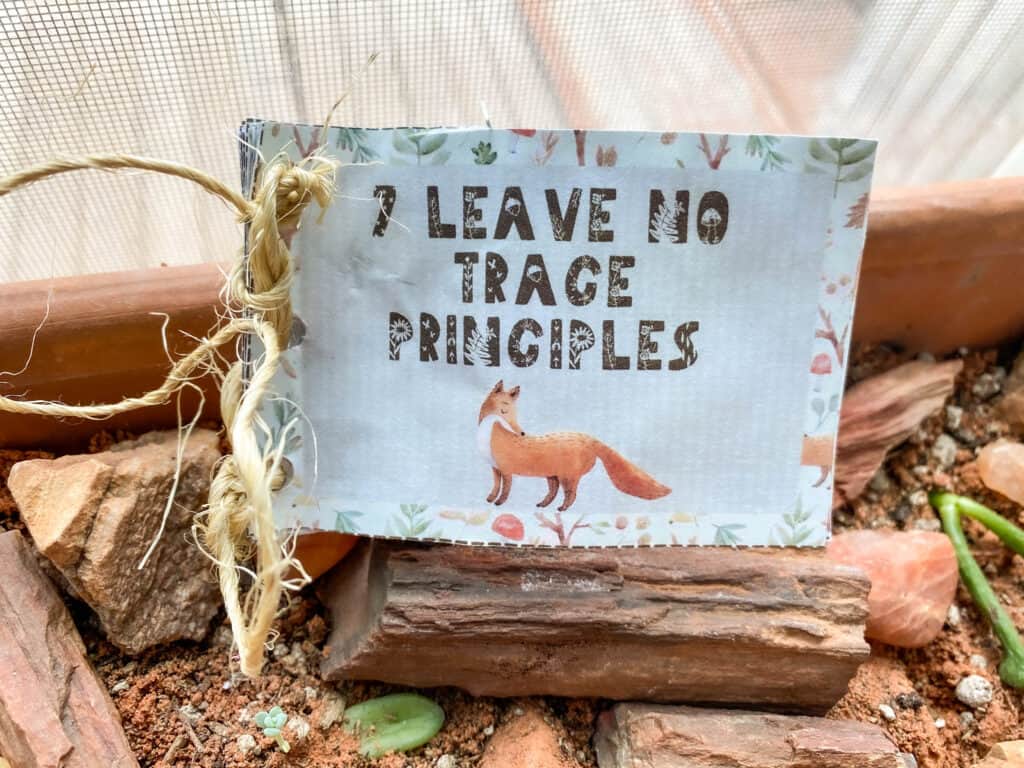
The Seven Leave No Trace Principles (Don’t forget your PDF printables!)
Here are the 7 Leave No Trace principles.
- Plan ahead and prepare
- Travel and camp on durable surfaces
- Dispose of waste properly
- Leave what you find
- Minimize campfire impacts
- Respect wildlife
- Be considerate of other visitors
Let’s have a brief look at each of them. *And don’t forget to get your Leave No Trace printable for kids and adults!
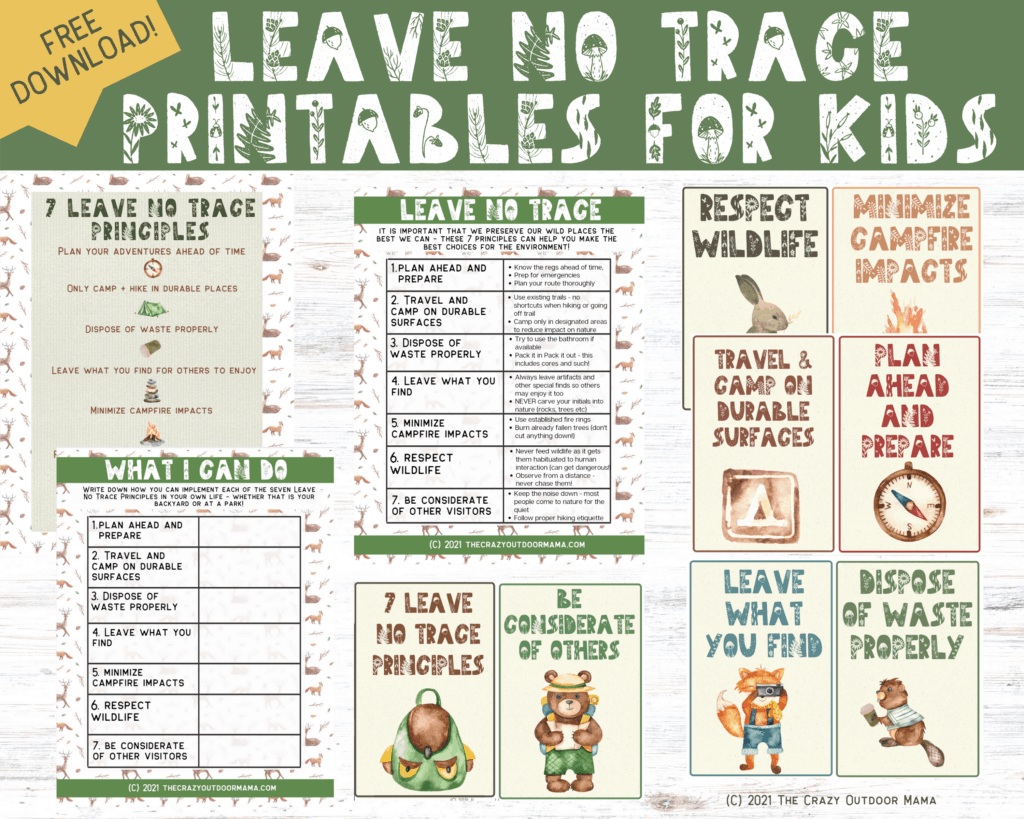
1 – Plan ahead and prepare
The first step is to plan ahead. If you’ve already read my Guide to Your First Backpacking Trip, you know how much emphasis I put on behind prepared.
When you properly plan ahead, not only will the trip be more enjoyable for you (forgetting your stove fuel can really put a damper on your backpacking trip), but it will make it easier to prevent damage to natural resources.
Here are a few tips for planning ahead to leave no trace while backpacking and hiking:
- Research ahead of time. Check the regulations for the area you’ll be visiting. Do they allow campfires? What permits will you need? Do you need to bring bear canisters?
- Prepare for emergencies. Check the weather beforehand and be ready for unexpected hazards. If someone needs to come rescue you, they won’t be worrying about leaving no trace, they’ll be focused on getting you out alive. And if you find yourself in an emergency situation, you’re more likely to make poor choices.
- Plan to hike in smaller groups. Large groups of people need bigger campsites, larger fires, and more places to take care of “business”.
- Package your food to minimize waste. Remove your food from bulky cardboard or plastic packaging. Pack your food in collapsible containers.
- Hit the trails during off-peak times. More foot traffic means nature will have less time to recover.
- Plan your navigation thoroughly. If you get lost, you’re more likely to head off the beaten path to find your way back.
2 – Travel and camp on durable surfaces
Basically, if a trail or campsite is already established, stick to it. Don’t make new ones. Backpacking isn’t the time to blaze new trails. Stick to established trails and avoid taking shortcuts.
If you’re in the backcountry where there are no established trails, walk and camp on durable surfaces where your footsteps won’t leave a lasting impact.
Here are a few tips for traveling and camping on durable surfaces:
In Frontcountry (Popular, well-traveled areas)
- Stick to existing trails and campsites. Avoid creating a brand new campsite just to get a better view.
- Walk single file in the middle of the trail. I know you’d love to walk side by side, hand in hand when hiking with your better half. But walking single file will help keep trails as small as possible.
- Don’t make campsites any bigger than they already are.
In Backcountry (Pristine areas that rarely see other backpackers)
- Avoid creating new trails or campsites. If you can tell where a previous hiker camped, choose another location. This dispersed use will help nature to heal.
- Camp and hike on durable surfaces like rock, dirt, gravel, dry grasses, and sand.
- Avoid hiking on areas near water sources or with delicate vegetation.
- Camp about 200 feet (70 big steps) away from rivers, lakes, and streams.
- The backcountry should look like you were never there.
3 – Dispose of waste properly
This refers to human waste (just to be clear… poop), trash, food scraps, and even rinse water. Anything that you brought into the area can be considered waste and could potentially affect the delicate balance of the ecosystem.
Here’s how to dispose of waste properly while backpacking and camping.
- If there’s a bathroom, use it. Believe me, I know… pit toilets can be stinky. But if it’s there, it’s best to use it.
- Pack it in, pack it out. Whatever you bring, take it back out with you. This even includes food scraps, wet wipes, toilet paper, and other hygiene products. Prepare accordingly with ziploc bags or another way to properly transport your waste.
- When it’s time to do number 2, make sure you’re about 200 feet or 70 steps away from any water sources. Dig a cathole about 6-8 inches deep. When you’re done, fill in the hole with the same dirt you removed.
TIP: Put your used toilet paper in a small bag for picking up dog doo-doo. Then put that in a sealable Ziploc bag. Double protection and you don’t see your dirty TP!
- Check local regulations on human waste. Some highly impacted areas require ALL human waste to be packed out.
- Use biodegradable soap for washing yourself and your dishes. Dispose of water 200 feet or 70 steps away from streams, lakes, and rivers. Don’t use soap directly in water sources. Bring a collapsible basin for doing dishes if necessary.
- Leave your campsite cleaner than when you found it. If someone else left trash, pick it up and pack it out.
4 – Leave what you find
There’s one thing you can always take.. PICTURES! Take as many as you want! Other than that, it’s best to leave things as they are.
- Don’t collect rocks, wildflowers, and a bunch of random sticks. Take pictures and leave them where they should be – in nature (not in an old shoebox in your closet collecting dust).
- Don’t damage trees by carving your initials into them or hacking off branches just to feel like a real mountain man (or woman).
- Resist the urge to build any kind of sleeping structure or camp “furniture”.
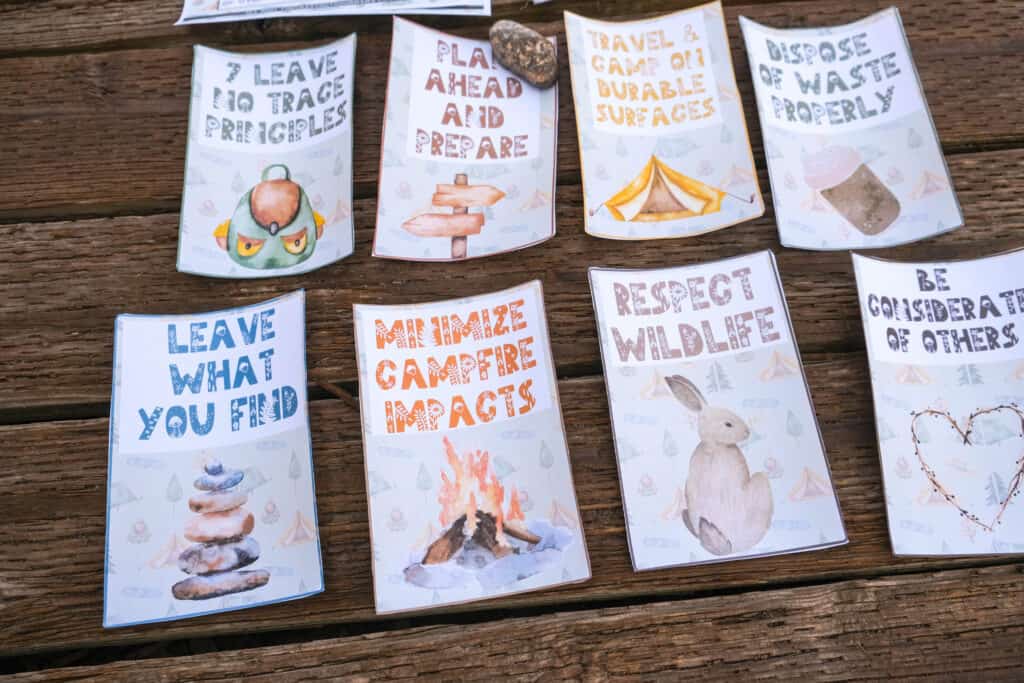
5 – Minimize campfire impacts
Oh, the beloved campfire. There’s nothing more relaxing than cozying up next to a roaring campfire. But they can also be one of the most destructive parts of a backpacking trip. An option that will cause less of an impact on the environment is to bring a lightweight cooking stove and a simple candle lantern.
A fun way to teach campfire safety to kids is through this tasty safety campfire food activity – it includes a free printable talking about the steps needed to create a safe campfire.
If there are no fire bans in effect and local regulations allow you to create a fire, here’s how you can minimize its impact:
- Use established fire rings.
- Don’t make the fire any bigger than it has to be. Better yet, keep it small.
- Burn small sticks that have already fallen to the ground.
- Don’t bring any wood from home. This could introduce new bugs and pests into the local ecosystem.
- Be sure fires are completely put out. Burn all the wood to ashes and then scatter the cool ashes.
TIP: If you’re allowed to make a fire but there’s no established fire pit, try one of these portable fire pits!
Solo Stove Bonfire Firepit (like the one in the picture below from our most recent desert trip!) – These don’t damage the ground underneath, they have handy spark arrestors, and BARELY any smoke! Get a smokeless campfire and a place to cook!
* Related: Solo Stove Bonfire Review – Is it worth the $$$ ?
UCO Flatpack Portable Stainless Steel Grill and Fire Pit
Fireside Outdoor Pop-Up Fire Pit
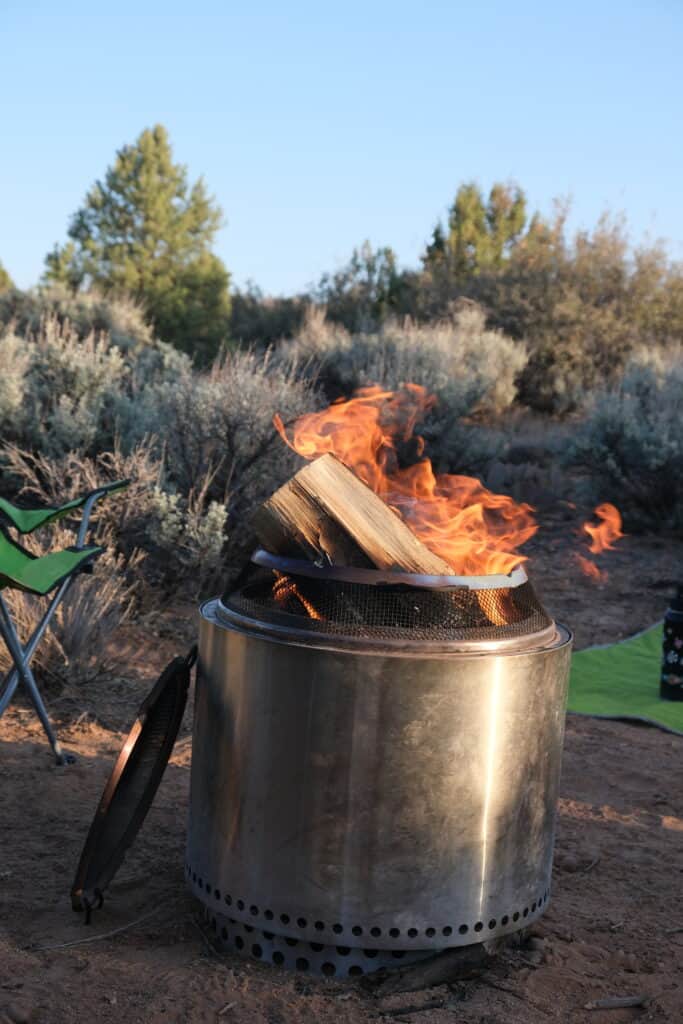
6 – Respect wildlife
I know, I know… a picture of you feeding some spam to a grizzly bear would look pretty sweet on your Instagram feed. But it’s not a good idea. Not only is approaching wild animals dangerous for you, but it’s also bad for the animals as well.
Here are some tips for respecting the wildlife:
- Observe them from a distance
- Bring binoculars or a zoom lens
- Never feed wildlife. It’s unhealthy and gets them used to interacting with humans which will lead to unwanted encounters in the future.
- Store your food securely and use bear canisters if you’re in bear country.
- Especially avoid wildlife during mating season, when raising young, during the winter, or when they’re likely to be hungry. (This is generally good advice for interacting with fellow humans as well! LOL!)
7 – Be considerate of other visitors
Just because you’re away from civilization doesn’t mean you can become “uncivilized”. Treat others as you would like to be treated. Think about how your actions will affect fellow hikers and campers.
- Keep the noise down. Def Leppard blaring through your battery-powered speaker would probably sound great at a campsite in the Grand Canyon, but it’s best to keep noise to a minimum.
- Most people head outdoors to find peace. Keep the peace. Give them their space.
- Follow proper hiking etiquette.
- If you bring your pets, keep them under control at all times.
Get Your Leave No Trace Printable for Kids
Want an easy way to remind yourself and your kids about LNT best practices?
Get access to the leave no trace printable pdfs that you can print, cut out, and laminate. Just slip them in your backpack or camping kit and you’ll have them for easy reference while on the trail. There’s even a kid-friendly version to help your kids get excited to leave no trace!
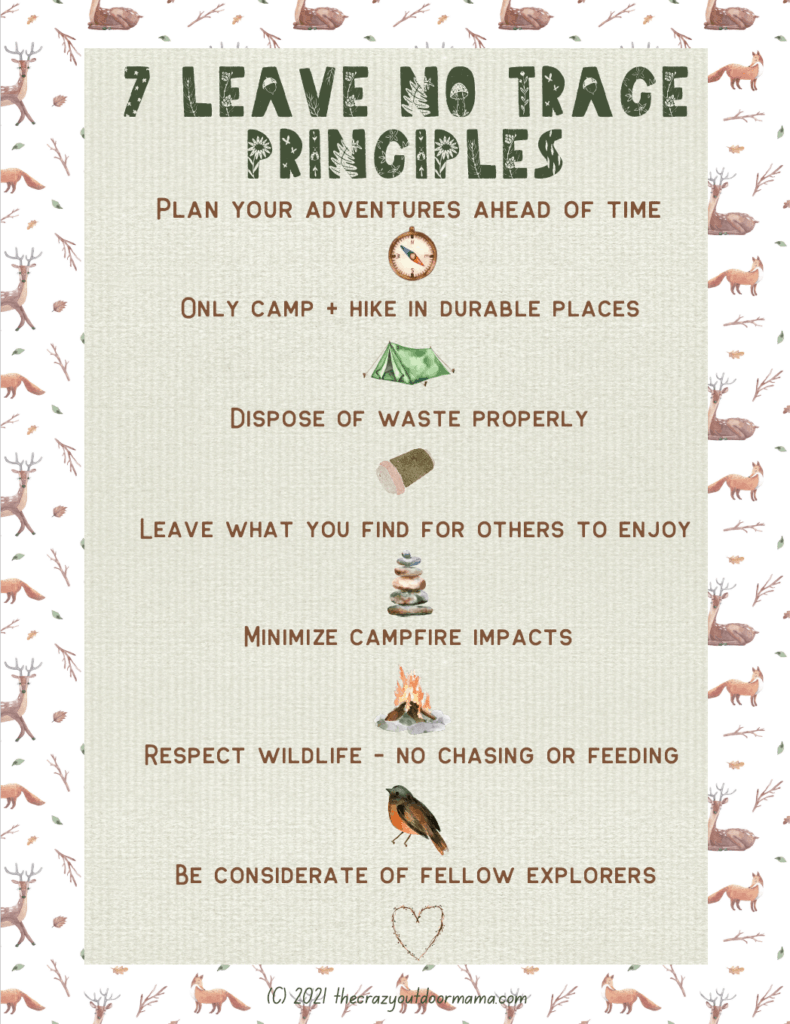
We Need Nature – Let’s Take Care of It
So the next time you head out on a backpacking trip (or even just to the park to walk your dog), remember the seven Leave No Trace principles.
- Plan ahead and prepare
- Travel and camp on durable surfaces
- Dispose of waste properly
- Leave what you find
- Minimize campfire impacts
- Respect wildlife
- Be considerate of other visitors
P.S. if you’re passionate about Mother Earth, I bet you’ll also enjoy this list of eco conscious movies (for all ages!) and these Earth Day themed Color By Number Printables!
Want some more practical tips for your next backpacking trip? Don’t miss my other backpacking articles!
- 7 TIPS FOR CONQUERING YOUR FIRST BACKPACKING TRIP
- 6 SIMPLE BACKPACKING RECIPE IDEAS + HOW TO CREATE YOUR OWN!
- HOW TO PURIFY WATER WHILE BACKPACKING | THE COMPLETE GUIDE
- BACKPACKER SURVIVAL SKILLS | 11 BASIC OUTDOOR SKILLS YOU NEED FOR YOUR FIRST HIKE
- BEGINNER’S GUIDE TO PACKING A BACKPACK FOR HIKING | EXPERT TIPS TO HELP YOU PACK LIKE A PRO
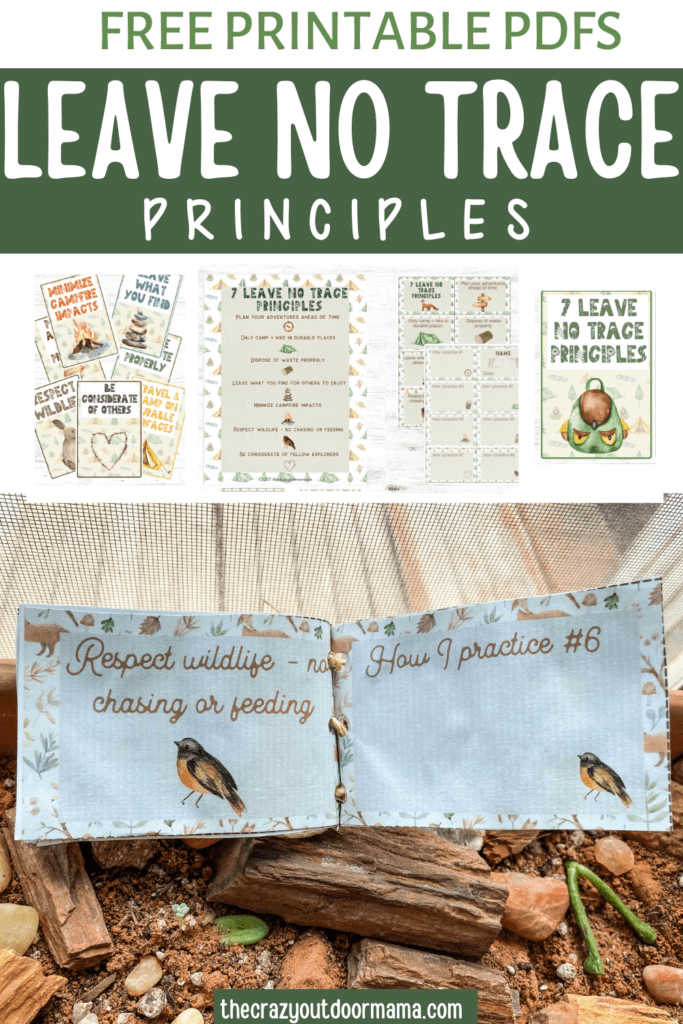
- Solar Eclipse 2024 Kids Printable Activity Pack! - April 8, 2024
- 11 RV Bathroom Makeovers to Inspire You! - April 7, 2024
- 13 Dreamy Hammock Camping Set Up Ideas + Pics - February 22, 2024
